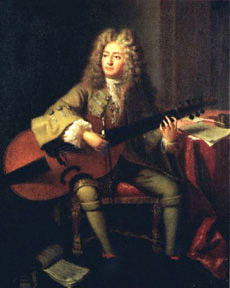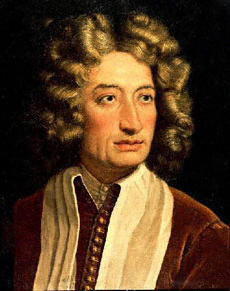

This arrangement of La Folia is a medley of La Folia music composed by Marin Marais, Arcangelo Corelli, and Antonio Vivaldi. Marin Marais (1656-1728) was a French composer and studied composition with the prominent French composer Jean-Baptiste Lully (1632-1687). Marais was a viol virtuoso, and became a member of the King Louis XIV’s royal orchestra, eventually acquiring the honored position of Ordinaire de la chambre du Roi pour la viole (roughly translated to mean "regular violist of the King’s chambers"). Marais composed instrumental music and operas, and is particularly noted for his viol compositions. He published five collections of viol music, comprising more than 550 pieces. The name of his arrangement of La Folia was "Couplets des Folies d’Espagne," and it came from his Book 2 collection of viol music, Pièces de viole, published in 1701. [5]

Arcangelo Corelli (1653-1713) was an Italian composer and violinist, and was particularly famous for his solo sonata, trio sonata and concerto instrumental compositions. Some of his patrons included Queen Christina of Sweden, Cardinal Benedetto Pamphili and Cardinal Pietro Ottoboni. Corelli’s version of La Follia came from his Sonata No. 12, Op.5, a set of 12 sonatas published in 1700, and he dedicated Op.5 to the Electress Sophie Charlotte of Brandenburg. Op.5 was one of Corelli’s most popular collections of music, and at least 42 editions of Op.5 were published by 1800 (advances in music publishing during this time period contributed to the widespread popularity and accessibility of Corelli’s music). [6]
Corelli’s Op.5 was a set of 12 sonatas for solo violin with a basso continuo accompaniment. The term basso continuo (also known as continuo or figured bass) describes a bass part in a composition, generally annotated with numbers to indicate harmonic intervals that should be played above the bass line. During the Baroque period, the continuo was generally performed by a keyboard player (such as a harpsichord) to provide a harmonic accompaniment, and a cello frequently played the continuo part along with the harpsichord.
Op.5 is a set of sonatas, and the word sonata comes from the Italian word suonare meaning "to sound" or "to be played," as opposed to cantata, a vocal work which means "to be sung." A sonata is an instrumental form of music and describes a multi-movement work for an instrument, often with accompaniment. The term has had varied meanings during different music eras, and during the early Baroque period, sonata was an imprecise designation for an independent piece of music with several movements, for a few instruments with a basso continuo accompaniment. The trio sonata was one of the most popular forms of sonatas used during the Baroque period, and the instrumentation generally used in trio sonatas consisted of two violins and continuo.
Corelli was a central figure in the evolution of the sonata. Two types of sonatas were popular during the Baroque era: church sonatas (sonate da chiesa) and chamber sonatas (sonate da camera). Corelli’s church sonatas, or sonate da chiesa, generally had a four movement structure of slow-fast-slow-fast. The first movement was often a processional, French-overture type of movement; the second movement was generally fast and imitative, often a fugue; the third movement was in a lyrical, aria style; and the fourth movement often was a fast, bipartite dance form. Corelli’s chamber sonatas, or sonate da camera, were basically a collection of binary dances based on French dances with no set number of movements. These two forms of sonatas, church and chamber sonatas, eventually merged before the Baroque period ended. During the Classical period, sonata came to mean a multi-movement work for a solo instrument with piano accompaniment, or piano alone. [7] [8]
Antonio Vivaldi (1678-1741) was a virtuoso violinist and composer of instrumental music, operas and sacred music. He was born in Venice, Italy, and studied the violin with his father, Giovanni Battista, a professional violinist. At the age of twenty-six, Vivaldi was appointed maestro di violino at the Pio Ospedale della Pietà, one of four Venetian institutions for illegitimate, orphaned, or abandoned girls. This particular orphanage specialized in music and had many fine musicians and an exceptional orchestra. Vivaldi's responsibilities eventually included teacher of violin, director of concerts, choirmaster, and composer. Many of his symphonies and concertos were composed for student and faculty associates of la Pietà.
Vivaldi earned a living as a musician not only through his affiliation with la Pietà, but also through the sale of his music in manuscript and published forms. He composed over 800 works such as approximately 500 instrumental concertos, over 90 solo and trio sonatas, and a vast array of instrumental chamber music, operas, masses, oratorios and cantatas. Vivaldi’s "Variations on La Follia" is part of a set of 12 trio sonatas, Op. 1, No. 12 (the earliest known edition is dated 1705). Op. 1, No. 12 was scored for two violins and a basso continuo part. [9]
La Folia originated as a dance song in the late 15th century in countries such as Portugal. The word folia means "mad" or "empty-headed," and apparently was used because the dance originally was so fast and tumultuous, that it appeared as if the dancers were crazy or mad. Later versions of La Folia adopted a more stately and moderately paced tempo, and La Folia soon became popular in other countries such as Spain, Italy, France and England. Many composers have written folia variations, and just a few of the noted musicians who have done so include: Marais, Corelli, Vivaldi, Lully, Scarlatti, J.S. Bach, C.P.E. Bach, Grieg, Liszt and Rachmaninoff.
This version of La Folia is a set of variations movements, often called variation sets. The main theme is clearly expressed in the first eight measures of the piece, followed by increasingly complex rhythmic and melodic variations (the harmonic structure remains the same). This piece also uses an ostinato, a term which means "obstinate" in Italian. An ostinato is a short musical pattern, e.g. a melodic, rhythmic or harmonic figure, persistently repeated throughout a composition. The theme of this piece may be described as an ostinato, and as mentioned earlier, the La Folia theme or ostinato is used as the subject of a series of melodic-rhythmic variation movements. [10] [11]
TECHNIQUE TIPS: This arrangement of La Folia includes four variations of the La Folia theme, and features the compositions of Marais, Corelli and Vivaldi. Use a moderately slow and stately tempo as you begin the piece. The main theme is simply stated in the first eight measures, and is then repeated, ending with a slight variation in the harmony. The different variations of the theme in this arrangement will require the use of varied cello techniques such as slightly separated notes for Corelli’s Variation 2 (beginning in measure 33); slurred or separate bows for the triplets in Vivaldi’s Variation 3 (beginning in measure 41); and short, fast 16th notes for Corelli’s Variation 4 (this variation begins in measure 57, and you may want to play this section using the upper 1/3 of your bow). If some of these variations are too difficult for you, try playing the main theme found in the first eight measures of the piece along with the piano accompaniment during the technically challenging variations. If you’re playing this piece with the piano accompaniment or a recorded version of this arrangement, note how Vivaldi’s Variation 3 has a descant part, an interval of a third above the melody part (Vivaldi’s original La Folia score was written for 2 violins).
© Copyright 2025 RK Deverich. All rights reserved.
Although this online bass class is provided free of charge, all rights are reserved and this content is protected by international copyright law. It is illegal to copy, post or publish this content in any form, and displaying any of this material on other websites, blogs or feeds is prohibited. Permission is given for individual users to print pages and perform music from this website for their personal, noncommercial use.